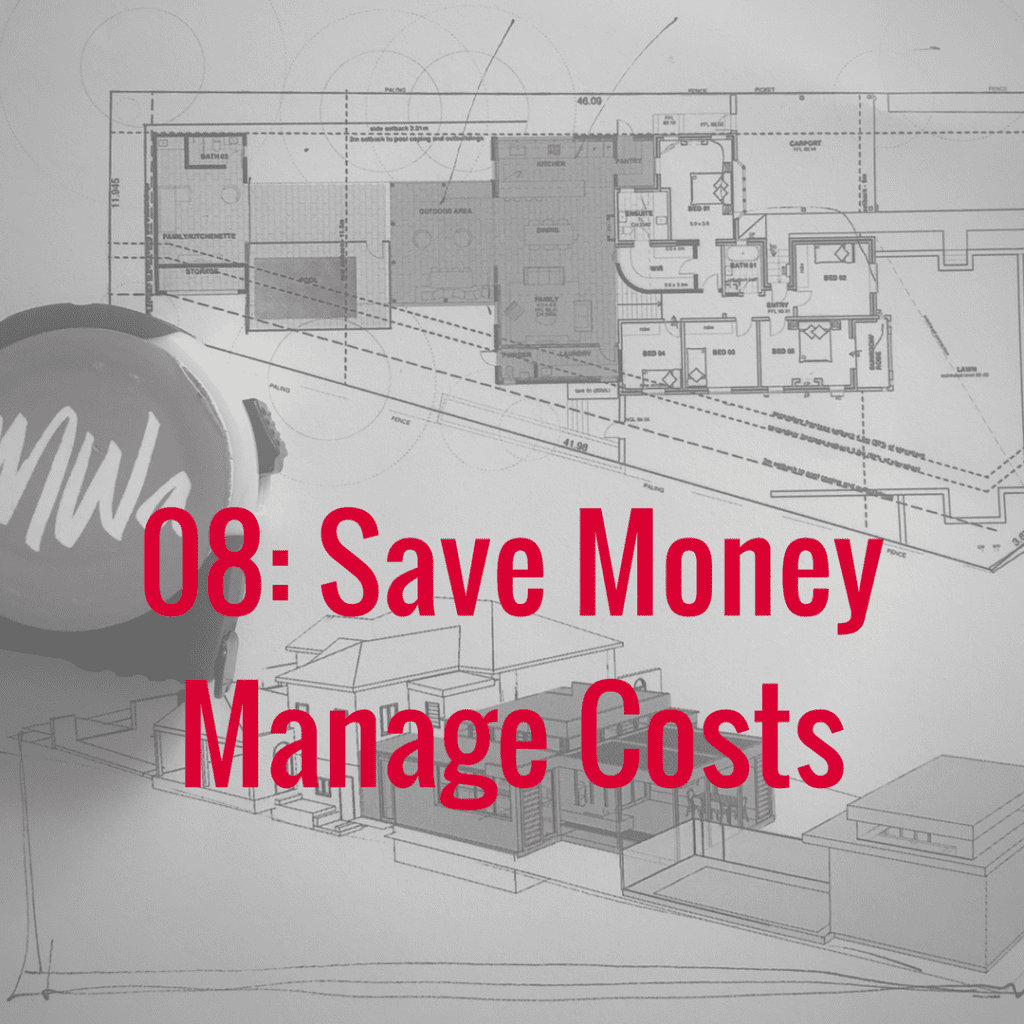8 MANAGE COSTS, SAVE MONEY: 10 Ways to Manage Costs & 10 Ways to Save Money On Your Residential Project

08 Manage Costs, Save Money: 10 Ways to Manage Costs & 10 Ways to Save Money
If you are about to build a new home or renovate, and you are cost conscious, the best way to save money on your project is to manage your costs.
It’s that simple.
Here are 10 ways to manage your costs to save money on your residential project, have it run smoothly and successfully and avoid the nightmare scenarios which seem so prevalent.
# 1 Do your homework at the start of your project, as follows:
Make an educated choice about which segment of the residential market suits you best. ie: project home, design and construct, individual solution. It’s not just about cost, it’s about time, complexity, energy, capacity, risk and how best to satisfy your desires and wishes. Read more about this 01 Architects – Do you need one?
Fix an overall project “spend”. Otherwise you are in the land of hope and promise. Your decisions are not real until there is a cost. Read more about this 02 Brief – Wish List, Shopping List & Priorities List.
Prioritise your needs and wants. Read more about this 02 Brief – Wish List, Shopping List & Priorities List.
#2 Get the big picture right.
The strategic design decisions you make at the beginning of your project will have the largest impact on your project costs, not fussing over the price of tiles towards the end of construction.
The more strategic the decision, often the greatest impact on cost.
Size and complexity of construction generally has an impact on building costs. A larger home will be more expensive than a smaller home. Roof terraces, upper floor balconies and roof gardens can be fabulous but require expensive construction. Excavation into rock to gain garaging / living space / outdoor levels is often feasible but expensive. Exceeding the hard/soft ratio for site cover for stormwater may incur additional on-site stormwater infrastructure. A pool and associated equipment including heating can easily cost $120K.
# 3 Do an OPC (Opinion of Probable Cost) with an architect and a consultant builder/QS at sketch design stage.
If you don’t establish the overall project cost at the start of the project, then you can’t manage costs and make decisions accordingly to adjust costs, selections, methods and cost allocations.
Waiting until the final tender process, or until you are building on-site to make changes, can waste time and money. ie: on processes such as additional approvals / Sec 96 modifications to a DA consent, changes to documentation including consultant documentation, changes on site to un-do or re-do work, delays in the smooth running of the project and program. Such changes are sometimes necessary for other reasons, but are not a an effective way to manage costs.
#4 Take out as many of the items that you can supply, out of the building contract, to save money on builder’s margin.
This strategy can deliver a substantial saving on your project.
On a construction contract of $1.2mil, supply items such as joinery, flooring, light fixtures and fittings, door hardware and a host of other possible items, depending on the particulars of the project.
However, but should be done in consultation with your architect and builder, to make sure it makes sense to do this. There are many items where its not appropriate and its essential that the builder is responsible for managing and overseeing the works. This includes their management, building quality and control, insurances etc. Builders earn their margin for a reason.
If this strategy is agreed upon, the building contract documentation and specification needs to reflect this arrangement, to cover items by owner, provisional sums and prime cost sums, and works excluded entirely from the building contract.
#5 Construction Costs & Project Costs: Know the Difference
A construction contract of $1.2mil can have a project cost of $1.6mil, when project costs such as consultant fees, statutory costs (council and utility authorities), items by owner, other works associated with the project but excluded from the works (for example, some repairs, fencing, landscaping etc) and costs to finish the project off property, like window coverings, essential furniture etc.
Other types of costs incurred by owners, not within the cost ballpark above, include finance costs and rental accommodation if required for the duration of the construction build.
These costs are all project specific but if you are cost conscious, these costs need to be identified and budgeted for at the beginning of the project to ensure the financial viability of the project.
#6 Do not save money by cutting out the architect and their fees.
Saving on architects fees does not translate into a project cost saving. In nearly all cases, it’s a false economy. Read more about this #7 below and refer to 07 Fees: Myth vs Reality.
#7 Engage your architect to document your project fully.
This is a sub set category related to #7.
Ironically, its the biggest mistake made by cost-conscious clients.
Not documenting a project heightens the risk that costs will blow out during construction, due to lack of considered design, materials selection & documentation, lack of co-ordination, lack of forethought as to the real scope of building works required.
Once construction has started, there are fewer ways, if any, to make significant amendments to the design or pull out of the construction works. Variations during construction are costly and will make your architect’s fees look like good value in hindsight.
It can easily cost $20K a week to have your builder on-site, so that the cost of any delays or mistakes on-site hugely outweigh the architects fees to plan ahead, co-ordinate and limit this risk.
Consider the following cliches:
“Failing to Plan is Planning to Fail” and “Measure Twice, Cut Once”
#8 Do a competitive tender.
Refer to 06 Time – How Long Will It Take? And How to Take 6 Months off a Renovation Timeframe for why avoiding a competitive tender can save you TIME.
However, if your objective is to SAVE MONEY, a competitive tender can be an advantage.
And its not by selecting the cheapest tender. It’s to test the approach and performance of your prospective builders, as a test run for their performance and attitude through construction. Test their conduct, responsiveness, references, thoroughness, their knowledge of your job and site. Create a small problem in during the tender process and see how they communicate with you.
A good relationship with the right builder will save you money and stress during construction.
Just like one of those TV Mastercard adds…”priceless”.
# 9. KIS(S). Keep it simple (stupid). KIMM. Keep it mostly modest.
Why does it cost so much to build or renovate today? Why is housing affordability an issue for most of Australia?
See more about this on the MWa blog: Housing Affordability and Your Renovation.
My observation is that affluence and expectations are contributing to our housing affordability crisis. Australian’s are building the 2nd largest homes in the world, after the US. Like walking past the buffet table, there’s so much choice and you can probably do with less. Keep this in mind with all the choices you make along the building journey.
# 10. Have a Contingency Sum set aside of at least 5% to 10%, and for complex alterations and additions 10% to 15%.
A contingency sum is an allowance set aside by the client, to provide for the unexpected. There are nearly always items which come up during building which were not anticipated or forseen, despite everyone’s best intentions. There are also frequently additional scopes of work which clients choose to undertake which were optimistically omitted from the building scope, to lower costs, at the beginning of the project.
A contingency sum is a hedge and a buffer. It lowers stress. A suggestion straight from Kevin McCloud’s Grand Design’s Handbook, if you don’t spend your contingency during the build, spend it on new furniture or a great family holiday!
Another contingency worth considering is a time contingency, especially on the anticipated move in date at the end of construction. Plan for a buffer of time and don’t make arrangements which are not flexible. This single factor alleviates an enormous amount of client stress at the end of a project which is easy to avoid completely, if thought about before hand.
10 WAYS TO SAVE MONEY
Finally, here are 10 tips for making materials selections for your project that will save you money
(which should always be balanced against what you really need and expect in terms of quality and performance).
- aluminium windows can be 25% cheaper than timber windows (ie: new home windows including flyscreens): $60K aluminium vs $75K timber)
- larger drawers in the kitchen can save $1000 per drawer on the overall kitchen costs, as the most expensive item of cabinetry are good quality drawer runners, not the carcasses themselves (ie: reducing from 12 drawers to 6 drawers saves $xx)
- the most expensive item in a new kitchen is likely to be the benchtops. Selecting from the standard Ceasarstone range Cat A $/sqm vs Cat C $/sqm.
- smaller format tiles / pavers / stone can be up to 50% cheaper than large format tiles from the same range ie: Eco Outdoor bluestone pavers 600 x 400x 20mm = $70/sqm vs 1000 x 1000 x 20mm $140sqm. Tiler labour to install larger format tiles will also be more than smaller more manageable tiles.
- floor mounted with back to the wall toilets with a regular cistern are generally cheaper and much easier to maintain than concealed cisterns
- design the bathroom so that frameless glass is not needed in the shower (frameless glass can be the most expensive item in a bathroom)
- get feature joinery like bookshelves made in moulded MDF board, installed and painted on-site, rather than polyurethane spray painted & finished
- select a decorative concrete block for exterior retaining walls rather than build with blockwork or brickwork that is then clad in stone. If a product can perform structurally, decoratively and is durable, its a better option and cost saving
- avoid doing stormwater on-site detention on your site, which can save from $5K to $30K
- avoid installing air conditioning and compensate with good passive design with cross ventilation and ceiling fans – save $25K in a/c installation costs and ongoing operational costs
Read on…click below on MWa’s client advice articles:
1 Architects – Do you need one? Is your project suitable?
3 Your Architect – A Good Match: How to find the right architect.
4 Process: Strategy, Vision, Compliance, Detail & Delivery: How it all works
6 Time – How long will it take?: How to cut six months off a renovation time frame.
8 Manage Costs, Save Money: 10 Ways to Manage Costs, 10 Ways to Save Money
